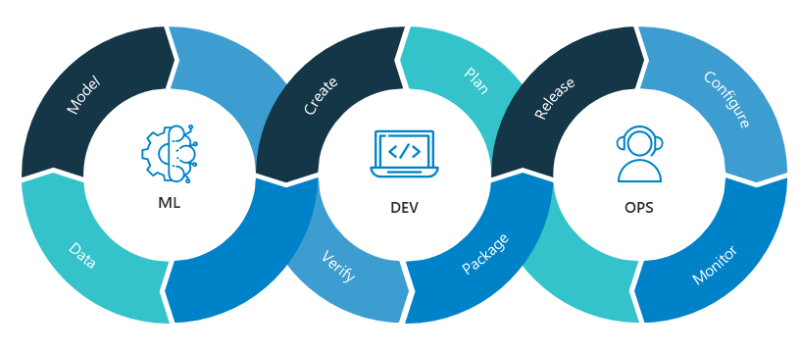Key Takeaways
MLOps stands for Machine Learning Operations, essential for deploying and maintaining ML models effectively.
It’s not just for large companies; startups and smaller teams can leverage MLOps for efficient scaling and innovation.
MLOps involves a series of phases from data gathering to model re-training, each critical for the model’s success.
Implementing MLOps can significantly reduce go-to-market time and operational costs while improving model performance.
If you’re considering MLOps for your organization, understanding its framework and best practices is the first step.
Let’s dive right in and unwrap this package labeled ‘MLOps’. Think of it like a toolbox that every modern tech team needs to keep their machine learning (ML) models not just running, but sprinting ahead in the race of innovation.
Quick Snapshot: MLOps Defined
Imagine you’ve just created a brilliant ML model. It’s clever, maybe even genius. But what now? How do you ensure it performs well consistently, adapts to new data, and remains valuable? That’s where MLOps comes in. It’s the backbone that keeps the model upright and evolving. In short, MLOps is a set of practices that helps teams manage the end-to-end lifecycle of a machine learning model.
Impact on Tech Teams: Why Care About MLOps?
Why should you, as a tech professional, care about MLOps? Because it’s the difference between a one-hit-wonder and a timeless classic. MLOps ensures your models are not just accurate, but also aligned with business goals, scalable, and compliant with regulations. It’s not just about building models; it’s about building models that last and perform.

“What is MLOps? | NVIDIA Blog” from blogs.nvidia.com and used with no modifications.
Diving into MLOps: The Core of Machine Learning Success
Success in machine learning isn’t just about crafting the most sophisticated algorithms; it’s about delivering value consistently and predictably. That’s the heart of MLOps. It’s a blend of ML, DevOps, and data engineering, all working in concert to transition a model from a clever idea to a fully-fledged, operational tool.
Breaking Down the Lifecycle: An Overview of Phases
The MLOps lifecycle can be broken down into distinct phases:
Data Gathering: Collecting the right data to train your models.
Data Analysis: Understanding and preparing your data for training.
Data Transformation/Preparation: Preprocessing data into a format that your models can learn from.
Model Training & Development: Teaching your model to make predictions or decisions.
Model Validation: Ensuring your model’s predictions are accurate and reliable.
Model Serving: Deploying your model so it can start doing its job.
Model Monitoring: Keeping an eye on your model to ensure it’s performing as expected.
Model Re-training: Updating your model with new data to keep it sharp.
Each of these phases is a gear in the MLOps machine. Miss one, and you risk the whole operation grinding to a halt.
For example, imagine you’ve trained a model to predict stock prices. If you skip the monitoring phase, you won’t catch when the model starts making inaccurate predictions because the market conditions have changed. Regular monitoring and re-training based on new data are crucial to keep your model on track.
Model to Market: Transitioning from Theory to Application
Developing a model is like building a high-performance sports car. But what good is it if you don’t take it out on the track? MLOps is about making that transition from the garage to the racecourse. It’s about applying the theory in real-world scenarios and ensuring it can withstand the twists and turns of actual use.
Let’s say you’ve got a model ready to identify fraudulent transactions. With MLOps, you can deploy this model seamlessly into your transaction processing pipeline, and it will start flagging potential fraud. But it doesn’t end there. MLOps keeps the model updated and effective as fraudsters evolve their tactics.
Now, remember that toolbox I mentioned? Imagine it’s filled with MLOps tools. They’re here to help you manage the entire lifecycle of your machine learning model. And the best part? These tools are not just for the big players. Even if you’re part of a startup or a small team, you can use MLOps to make sure your ML models are as sharp as a tack.
So, if you’re keen on making your mark in the world of machine learning, whether you’re just starting out or looking to scale up, understanding MLOps is not just beneficial; it’s essential. And if you’re looking for more guidance on how to implement MLOps in your projects, don’t hesitate to Contact Us. We’re here to help you navigate the MLOps landscape and ensure your ML models are primed for success.
For Tech Startups: A Gateway to Innovation
For the trailblazing startups out there, MLOps is not just a methodology; it’s a lifeline. It’s the secret sauce that can turn a good idea into a game-changer. Startups thrive on innovation, and MLOps provides the structure needed to iterate rapidly and push boundaries without losing sight of quality and reliability.
Established Enterprises: Scaling with Precision
Larger, established companies face a different set of challenges. They need to scale their ML efforts without disrupting existing systems. MLOps offers a roadmap for integrating new ML models into the complex ecosystems of big enterprises, ensuring that they enhance, rather than interfere with, ongoing operations.
Implementing MLOps: Paths to Operational Excellence
Implementing MLOps is not a one-size-fits-all scenario. It’s a journey that varies from organization to organization. However, the destination is the same: operational excellence. This means having a smooth, efficient process for deploying and maintaining ML models that drive value for your business.
Whether you’re a startup looking to disrupt the market or an enterprise aiming to innovate within, the right MLOps strategy can make all the difference. It’s about finding the balance between agility and stability, innovation and reliability, theory and practice.
Most importantly, it’s about recognizing the need for a structured approach to machine learning. Without MLOps, you’re essentially navigating a maze in the dark. With it, you have a map, a flashlight, and a clear path forward. And if you’re unsure how to start, reaching out to an expert can set you on the right path. Don’t hesitate to Contact Us for a consultation on implementing MLOps tailored to your unique needs.
“MLOps is not just a good practice; it’s a competitive advantage. It allows you to move faster, with more confidence, and with better results.” – Tech Innovator
Blueprints for Success: Strategies and Best Practices
Adopting MLOps is like building a house. You need a solid blueprint to guide you. That blueprint includes clear strategies and best practices such as:
Establishing cross-functional teams that include data scientists, ML engineers, and operations professionals.
Creating a culture of continuous learning and improvement, where feedback is valued and acted upon.
Investing in the right tools that support the entire ML lifecycle, from data preparation to model monitoring.
By following these guidelines, you can ensure that your ML projects are not just successful, but also sustainable in the long term. For those involved in the operational aspect, understanding tools like Kubernetes can be invaluable. Learn more about Kubernetes deployment strategies and tips to enhance your operational efficiency.
Tackling Common Setbacks: Troubleshooting Tips
Even with the best strategies in place, you’ll inevitably encounter challenges. Common setbacks in MLOps include data quality issues, model drift, and operational bottlenecks. For operational issues, understanding how to restart Kubernetes deployments might be particularly useful. Here are some troubleshooting tips to keep you moving forward:
Regularly review and clean your data to prevent garbage-in-garbage-out scenarios.
Implement model monitoring to quickly detect and correct drift.
Use automation to streamline repetitive tasks and free up your team to focus on more strategic initiatives.
By anticipating these challenges and having a plan to address them, you’ll be better equipped to maintain the health and performance of your ML models.
Powering Future Tech: MLOps As a Norm
As technology continues to advance, MLOps is becoming the norm rather than the exception. It’s a critical component in the machine learning ecosystem, ensuring that models deliver ongoing value. The role of data scientists is evolving too, with a greater emphasis on operational skills and collaboration.
Transforming Roles: From Data Scientists to MLOps Engineers
The integration of MLOps into the workflow is transforming the role of data scientists. They’re becoming MLOps engineers, with a focus not just on building models but also on deploying and maintaining them. This shift is creating a new breed of tech professionals who are as comfortable with operational challenges as they are with algorithms.
The transformation is profound. It’s not just about adding a new skill set; it’s about changing the way we think about machine learning. It’s about creating a seamless bridge between the theoretical and the practical, ensuring that ML models serve their intended purpose in the real world.
Cutting-Edge Trends in MLOps
As we look to the future, several cutting-edge trends are shaping the MLOps landscape:
Automated machine learning (AutoML) is reducing the barrier to entry, making it easier for non-experts to build and deploy models.
Increased focus on ethical AI and explainability is driving the need for more transparent and accountable ML practices.
The rise of edge computing is pushing MLOps to new frontiers, requiring models to run efficiently in resource-constrained environments.
These trends underscore the dynamic nature of MLOps and its central role in the future of technology. By staying abreast of these developments, tech professionals can ensure they’re at the forefront of the field.
If you’re ready to harness the power of MLOps for your organization, or if you have more questions about how it can benefit your projects, we’re here to help. Contact Us today to start your journey towards operational excellence with MLOps.
Frequently Asked Questions (FAQ)
As we wrap up our exploration of MLOps, let’s address some of the most common questions that might be lingering in your mind. These questions highlight the practical aspects of MLOps and can provide further clarity on its application and benefits.
What Exactly Is MLOps and How Does It Differ from AI?
MLOps, or Machine Learning Operations, is a set of practices designed to streamline and automate the end-to-end machine learning lifecycle. It’s about bringing a systematic approach to building, deploying, and maintaining ML models in production. AI, or Artificial Intelligence, is a broader concept that encompasses machine learning, but also includes other techniques like rule-based systems. MLOps specifically focuses on the operational aspects of ML within the AI spectrum.
For instance, if AI were a car, then ML would be the engine, and MLOps would be the maintenance practices that keep the engine running smoothly over time.
When Is the Right Time for a Company to Implement MLOps?
The right time to implement MLOps is as soon as your organization starts working with machine learning models. Early adoption ensures that models remain scalable, manageable, and aligned with business objectives from the outset. However, it’s never too late to integrate MLOps into existing ML projects to improve efficiency and performance.
Can Small Teams Benefit from MLOps?
Yes, absolutely. Small teams, in particular, can reap significant benefits from MLOps as it enables them to manage ML projects more effectively with limited resources. By automating various aspects of the ML lifecycle, MLOps allows smaller teams to compete with larger organizations by enhancing their productivity and the reliability of their ML models.
MLOps can help small teams to adopt best practices early on, setting a strong foundation for future growth and scaling.
How Can MLOps Impact an Organization’s Bottom Line?
MLOps can have a profound impact on an organization’s bottom line by improving the speed and quality of ML model deployment, reducing downtime, and ensuring that models continue to provide value over time. Efficient MLOps practices can lead to cost savings by minimizing the need for manual intervention and allowing for quicker iteration and innovation.
What Are the First Steps to Adopting MLOps in an Organization?
To start with MLOps, here are some actionable steps: understanding core elements like Kubernetes components is essential for orchestration and management of containerized applications, which is a key part of MLOps.



